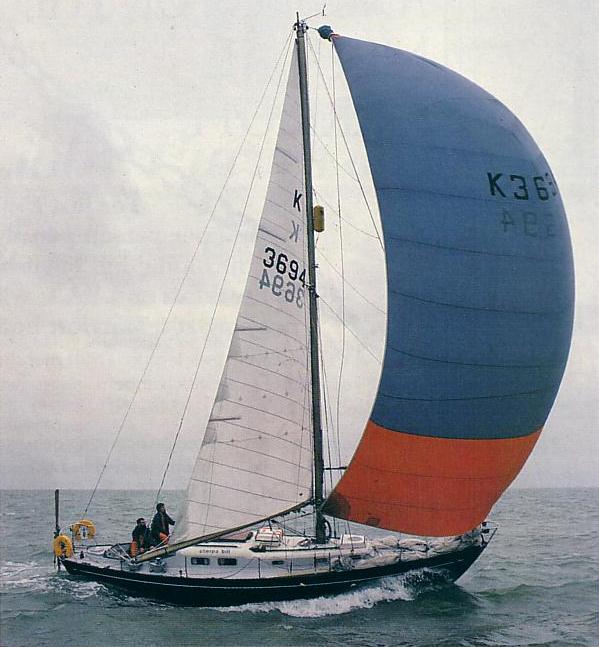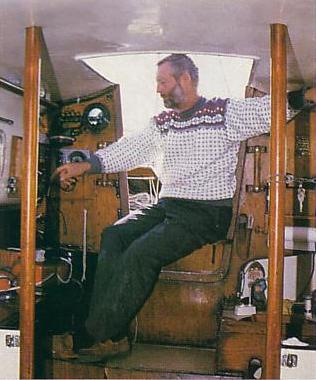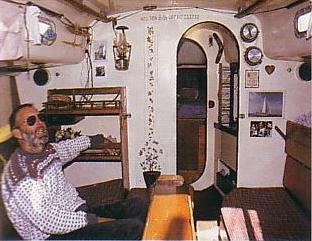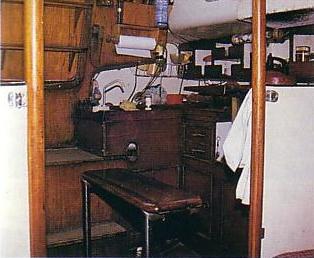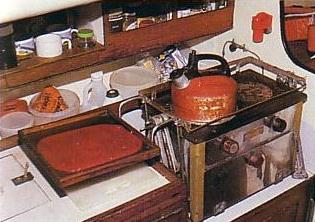Yachting Monthly December 1994
One man and his boat
After 1,001 days and 36,000 miles, Bill Perkes, his wife Hazel, and Sherpa Bill, an Excalibur 36, returned home to Cowes in June – the end of yet another chapter in Bill’s rich and rewarding life afloat.
I first met Bill eight years ago at the start of TWOSTAR, when he was racing with Willy Ker on board Assent, a Contessa 32. Since then he has taken Sherpa Bill across to the Caribbean twice, competed in a Yachting Monthly Triangle Race, and completed a circumnavigation.
His first boat was a home-built canoe, followed by a string of similar craft, including Bobcat, still in the family after 41 years. He raced her successfully and cruised all over the country, including the Western Isles of Scotland.
Following his marriage to Hazel, they bought Cornelia, a Dutch barge which became their home on the Thames for several years, taking her across to Holland on several occasions. The arrival of their two children, Fiona and Richard, highlighted the need for the stability of a house, and Cornelia was sold.
Then came a succession of various craft, including a 22ft Maple Leaf, a B-Class sailing canoe, a motor-canoe,, Firefly and an Atalanta called Sherpa.
It was in the Atalanta that Bill entered the 1974 Round Britain Race, which he managed to finish despite losing the rudder and breaking the mast.
Sherpa Bill was purchased in 1975. Since when they have undertaken eleven transatlantic crossings together, two of them singlehanded (Bill’s twelfth crossing was with Willy Ker on board Assent). They competed in the 1978 Round Britain Race, 1981 TWOSTAR, 1982 Round Britain Race, 1983 AZAB with Hazel, and the 1984 OSTAR.
In 1985 Bill took early retirement from business in London to concentrate on the more serious business of sailing, such as his two Atlantic circuits in 1986 and 1988. .
Over the years, the Excalibur has proven herself to be an ideal longdistance cruising boat. Naturally, some changes have been made to make life on board that much easier, especially when sailing singlehanded, but many features are original – the Barlow 24 winches, for example, and the Taylors paraffin stove, although a gimballed tray has been added to it. The spinnaker, too, is original. Even the fluorescent light tube in the saloon has yet to be changed.
On going below, one instantly feels that Sherpa Bill has been lived in and loved. She and Bill have achieved so much together and their affinity shows. He is aware of her every move, hearing every sound that she makes.
As her name suggests, she ‘carries’ him, and in return he cares for her. Their perfect partnership has enabled Bill to fulfill his life-long dream to sail around the world.
All around there are reminders of far-off places visited over the years -a boomerang from Australia, a model outrigger from Western Samoa, together with family photographs from home.
Despite spending so much time in the tropics, there is no fridge or freezer on board, but they managed perfectly well without. To make life more comfortable for the cook and navigator, Bill has made a portable seat which fits into lugs positioned on the centreline of the boat and can be folded up and stowed away when not in use.
The nav area to starboard opposite the galley still boasts the original grey box B&G echo sounder and log and they have been joined by a Navstar 2000S satnav, Raystar 590 GPS, Prosser Weathertrend, Lo-Kata Watchman and ICOM VHF. These are powered by three solar panels on deck and an Aquair 50 12v water generator.
Up in the forepeak, a watertight bulkhead has been added to prevent the whole boat filling with water in the event of a collision, and the twin berths made into a double with the addition of a shallow shelf below the cushions to accommodate the numerous charts required.
Another clever modification is the addition of steps inside and out to the washboards. These allow one to sit in the shelter of the companionway, beneath the ex-aircraft canopy that Bill added some years ago, and be within arm’s reach of the Autohelm and Aries controls, the tiller, winches and compass.
Beneath the companionway steps lies (Bill says rusting gently) a 19-year-old 12hp Yamaha singlecylinder engine, which produces 4 knots. For the entire three-year circumnavigation only 65 gallons of fuel was used.
Up on deck, several features have been added. After seeing a similar idea on a Swedish boat, Bill had a stainless frame made which fits over the coachroof and canopy and provides a useful high grabrail when going along the sidedeck to the mast.
The two vertical spinnaker tracks on the mast have been extended to allow the poles to stow up it. With all the guys permanently attached, they can be deployed by just dropping the sheet into the end of the pole and pulling down the inboard end.
During the entire circumnavigation only two things went wrong – the deck mast step unpeeled itself under the sideways pull of the kicking strap, and the exhaust manifold rusted and perforated, but both were repairable at sea. Otherwise everything went according to plan.
Having sailed from the UK to the Marquesas with various crew, Bill continued singlehanded to Tahiti, where Hazel joined him for the rest of the trip. By their return they had visited eighty-six islands and five mainlands – Venezuela, Panama, New Zealand, Australia and South Africa. Whilst in New Zealand, Bill had a cataract operation performed on both eyes which meant that he would no longer have to wear glasses full-time.
Upon their safe return home, life resumed as if it had never really been interrupted. Hazel once more took up her flower arranging, for which her talents are much in demand, and Bill went off racing in Sherpa Bill and Mitty, his Bembridge Scow.
Their life is constantly punctuated with letters, telephone calls and visits from cruising friends they have met on their travels. Whilst I was there the ‘phone rang; it was Trudie who runs the transatlantic ham radio net in Barbados. She was over in the UK; could she have lunch with them on Friday?
And the next chapter? Bill plans to walk from Land’s End to John O’Groats (slowly). MK
The stainless frame over the coachroof and ex-aircraft canopy provides useful hand-hold.
Seated on the adapted washboards in the shelter of the canopy, Bill is within arm’s reach of Sherpa Bill’s main controls.
The saloon carries reminders of home and faraway places. Bill painted the mural of the flowers on the bulkhead after removing the old cabin heater which was deemed unnecessary for the sort of cruising he had in mind.
A little comfort when cooking or navigating -the portable seat situated on the centreline.
The gimballed tray attached to the cooker.
Excalibur 36
Despite being designed primarily as a long-distance cruiser by E G van de Stadt in 1962, the Excalibur also enjoyed a successful racing career, winning the RORC Class II Championships in 1963, 1964 and 1965. Moulded by the Tyler Boat Co and fitted-out to a high standard by Southern Ocean Shipyard, the GRP design proved to be immensely strong. At the end of her production run in 1970, the Excalibur SK was available with a cutaway keel and spade rudder. In all, fifty-two boats were built.
An informal Owners’ Association is in the process of being formed. Anyone interested should contact Mrs Alex Ballard, Cider Cottage, Honey Hall Lane, Congresbury, Bristol BS 19 5JX (Tel: 0934 85320 1
Specifications
LOA 36ft 1 in
LWL 26ft 3in
Beam I Oft
Draught 5ft 11 in
Displacement 6.75 tons
Ballast 2.75 tons
Sail area (main and No I) 698sq ft


